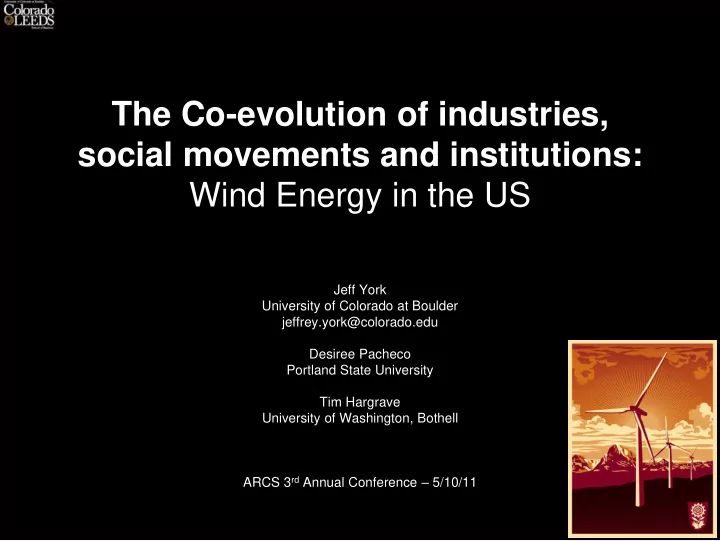

The Co-evolution of industries, social movements and institutions: Wind Energy in the US Jeff York University of Colorado at Boulder jeffrey.york@colorado.edu Desiree Pacheco Portland State University Tim Hargrave University of Washington, Bothell ARCS 3 rd Annual Conference – 5/10/11
Research Questions • What explains why wind energy emerged faster in some states than others? • How do social movements affect the industry and how does the emergence of an industry shape social movements? • Can we develop a process model for industry emergence?
Co-evolution • Interdependence and mutual influence of elements within and across levels of analysis within a system (Koza & Lewin, 1998; Lewin, Long, & Carroll, 1999; Lewin & Volberda, 1999)
Logics & Dialectics • Patterns of practice, values, and beliefs which shape the identities of individuals and organizations (Friedland & Alford, 1991; Thornton, 2002, 2004; Thornton & Ocasio, 1999, 2008) • Contradictions are ruptures and inconsistencies in social arrangements (Benson, 1977; Clemens & Cook, 1999; Seo & Creed, 2002; Sewell, 1992) • “…cultures revolve around core ideas that are oppositional or dualistic in structure” (Barley & Kunda, 1992: 385)
Data and Methods • Mixed Methods - Case study utilized for building process model - Wind Energy in Colorado 17 semi-structured interviews (Gov ’ t Officials, Entrepreneurs, - Activists, Utilities) - 546 newspaper articles - 4 site visits (NREL, CORE, Wind Firms) - 748 references from interviews, 682 from Denver Post
• Ecologizing: Emphasizes interdependence and maintenance of human and nature communities (Frederick, 1995; Gladwin et al., 1995)
• Economizing: Efficient use of resources for material improvement (Frederick, 1995; Gladwin et al., 1995)
DenverCam
• H1: There is a positive relationship between the participation in environmental SMOs in a state and the incidence of mandatory rules and standards related to wind power in that state • H2: There is a positive relationship between mandatory rules and standards favoring wind energy in a state and the growth of the wind energy industry in that state
“We work very closely with those environmental groups, but our focus is primarily on market development, on issues that are of great concern to the industry. We strongly support most of the goals that our environmental allies advance but, we don’t have the kind of non-profit orientation that a lot of our allies do in the environmental community. We’re more business - oriented, in a nutshell. “
• Hybrid organizations: “ organizations that combine institutional logics in unprecedented ways” ( Battilana & Dorado, 2010: 1419) • SMO: “ a complex, or formal, organization that identifies its goals with the preferences of the social movement or a countermovement and attempts to implement those goals” (McCarthy & Zald, 1977: 1217-1218) Hybrid SMO: A formal organization that identifies its goals with the preferences of a social movement and attempts to implement those goals through combining institutional logics in unprecedented ways.
• H3: There is a positive relationship between the growth of the wind energy industry in a state and the participation of clean energy SMOs in that state • H 4a & 4b: There is a positive relationship between the participation of clean energy SMOs in a state and the incidence of market incentives & visibility of the wind energy industry in that state
Process Model of Wind Industry Emergence H 5a & 5b: There is a positive relationship between wind energy visibility in a state and the growth of the wind industry in that state
Data and Methods Simultaneous Equations Model (3SLS – REG3) (Shrader et al., 2000; Gulati & Sytch, 2007) • 1999-2008 • Variables - Policy (RPS and Incentives), Firm Foundings, MW Wind Capacity, Environmental SMOs & Clean Energy SMOs (NCCS) • Controls - Legislature Political Party, Electricity Regulation, Wind Company Density, Wind Potential, LCV score, Median Income, MW Power Capacity, Education • Variety of Instruments employed in each equation – Other SMOs revenues (Clean energy SMOs), Wind energy policy (State revenues), Wind energy capacity (# Local utilities) , USGBC (Wind visibility)
Marginal Effects 5.8% 3.4% 42% 46% NS .08% 4.3%
Discussion • Explored co-evolutionary roles of industry, institutions and SMOs • Alternate model to “strategic” co -evolution • Hybrid logics and SMOs • Generalizability? Boundary conditions?
Thank You! jeffrey.york@colorado.edu
Recommend
More recommend